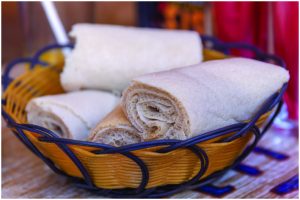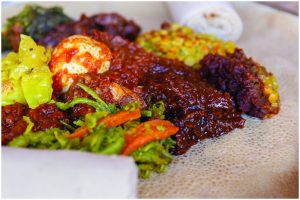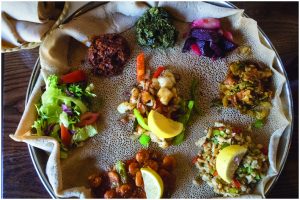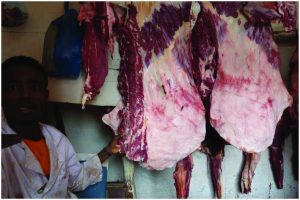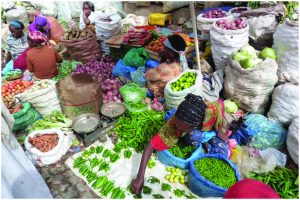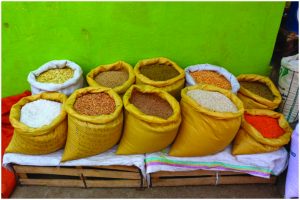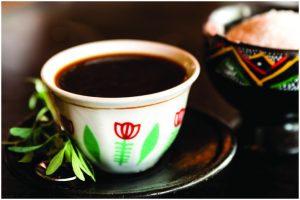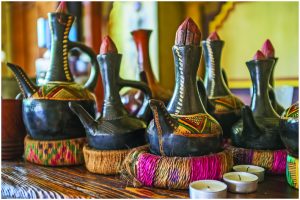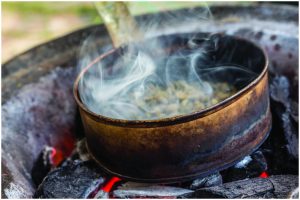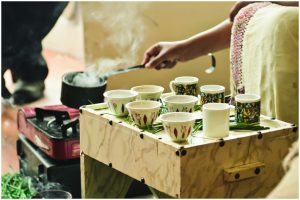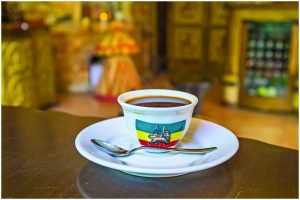Food & Drinks
Food
Traditional food is like much else in Ethiopia quite unique and taking part in a formal meal means participating in what resembles another of the country’s colorful and fascinating ceremonies. Ethiopian’s eat a lot of meat like beef, goat and sheep – if they can afford it. Orthodox Christians as well as Muslims do not eat pork, so this kind of meat will be hard to find. However, the country is also a paradise for vegetarians and vegans since the Orthodox Christians have a lot of fasting periods during the year when they do not eat any animal products. The Ethiopians cuisine offers a variety of vegetables, vegetarian sauces and stews as well as different kinds of cheese.
Injerra is a national dish and forms the base of every meal. It is made from a cereal grain that is unique to Ethiopa and known as teff. teff is milled to flour and made into batter. The batter is allowed to sit for a while so that the yeast can become active. When the batter is ready it is poured on a large flat oven and cooked like a pancake. The Injerra is spread out on a large tray and different sorts of sauces, meat and vegetables are dished out on it. You can tear of a piece of Injerra with your right hand and scoop up the food with it.
Wot is a national dish of Ethiopia made of free range chicken and hard boiled farm raised egg stew seasoned with Ethiopian spices and Berbere. In the highlands bege (lamb) is the most common constituent, while in lowlands figel (goat) is most used. On fasting days meat dishes are avoided and various vegetarian versions of wot are available.
Kitfo is a finely chopped beef tartar marinated in mitmita (chili spices) and kebe (clarified butter infused with herbs and spices). Traditionally served raw, or served leb leb (lightly cooked), or tibse (cooked). Kitfo special is served with ayibe (cottage cheese) and gomen (spinach).
Tibs is meat grilled or sauteed along with vegetables. It is served in a variety of manners and can range from hot to mild or contain little to no vegetables. There are many variations of tibs, depending on type and size or shape of the cuts of meat used.
Tere Sega is considered as something luxury in Ethiopia. The raw meat is traditionally served on weddings and special occasions. The dish is accompanied with awazi (a mustard chili sauce) and berbere.
Shiro is made of dried beans ground into a powder seasoned with onions, garlic, and berbere, and finally made into a stew called Beyanetu.
Traditional Drinks
The story of coffee has its beginnings in Ethiopia, the original home of the coffee plant, Coffee Arabica, which still grows wild in the forest of the highlands. While nobody is sure exactly how coffee was originally discovered as a beverage, it is believed that its cultivation and use began as early as the 9th century. Some authorities claim that it was cultivated in the Yemen earlier, around AD 575. The only thing that seems certain is that it originated in Ethiopia, from where it traveled to the Yemen about 600 years ago, and from Arabia it began its journey around the world.
Among the many legends that have developed concerning the origin of coffee, one of the most popular account is that of Kaldi, an Abyssinian goatherd, who lived around AD 850. One day he observed his goats behaving in abnormally exuberant manner, skipping, rearing on their hind legs and bleating loudly. He noticed they were eating the bright red berries that grew on the green bushes nearby. Kaldi tried a few himself, ad soon felt a novel sense of elation. He filled his pockets with the berries and ran home to announce his discovery to his wife and she told him to give the berries to the monks, whose threw them into the fire. After they smelt the aroma, they picked the berries out again and covered with hot water to preserve their goodness. That night the monks sat up drinking the rich and fragrant brew, and from that day vowed they would drink it daily to keep them awake during their long, nocturnal devotions.
While the legends attempt to condense the discovery of coffee and its development as a beverage into one story, it is believed that the monks of Ethiopia, may have chewed on the berries as a stimulant for centuries before it was brewed as a hot drink.
Another account suggests that coffee was brought to Arabia from Ethiopia, by Sudanese slaves who chewed the berries en route to help them survive the journey. There is some evidence that coffee was ground and mixed with butter, and consumed like chocolate for sustenance, a method reportedly used by the Galla tribe of Ethiopia, which lends some credence to the story of the Sudanese slaves. The practice of mixing ground coffee beans with ghee (clarified butter) persists to this day in some parts of Kaffa and Sidamo, two of the principle coffee producing regions of Ethiopia,. And in Kaffa, from which its name derives, the drink is brewed today with the addition of melted ghee which gives it a distinctive, buttery flavour.
Today, Coffee holds a sacred place in Ethiopia. Already the growing and picking process of coffee involves over 12 million Ethiopians and produces over two-thirds of the country’s earnings. The best Ethiopian coffee may be compared with the finest coffee in the world, and premium washed Arabica beans fetch some of the highest prices on the world market.
Ethiopia’s coffee ceremony is an integral part of their social and cultural life. An invitation to attend a coffee ceremony is considered a mark of friendship or respect and is an excellent example of Ethiopian hospitality. The ceremony is usually conducted by one young woman, dressed in the traditional Ethiopian costume of a white dress with colored woven borders. The long involved process starts with the ceremonial apparatus being arranged upon a bed of long scented grasses. The roasting of the coffee beans is done in a flat pan over a tiny charcoal stove, the pungent smell mingling with the heady scent of incense that is always burned during the ceremony. The lady who is conducting the ceremony gently washes a handful of coffee beans on the heated pan, then stirs and shakes the husks away. When the coffee beans have turned black and shining and the aromatic oil is coaxed out of them, they are ground by a pestle and a long handled mortar. The ground coffee is slowly stirred into the black clay coffee pot locally known as ‘jebena’, which is round at the bottom with a straw lid. Due to the archaic method used by Ethiopians, the ground result can be called anything but even, so the coffee is strained through a fine sieve several times. The lady finally serves the coffee in tiny china cups to her family, friends and neighbors who have waited and watched the procedure for the past half-hour. Often it is complemented by a traditional snack food, such as popcorn, peanuts or cooked barley. In most parts of Ethiopia, the coffee ceremony takes place three times a day – in the morning, at noon and in the evening. It is the main social event within the village and a time to discuss the community, politics, life and about who did what with whom. In a world where time has long become a commodity, the Ethiopian coffee ceremony takes us back to a time when value was given to conversation and human relations.
Tej (honey wine) is pronounced as in T’édge, and is the generic name for Ethiopian traditional Honey Wine or Mead.The drink is one of the special elixirs only available in Ethiopia. Be careful though – this sweet wine packs a punch. Tej is served in tej bet (Tej House, similar to Coffee House), or special bars set up strictly to sell tej either by the glass (berele) or by the bottle to take home. Several restaurants serving traditional Ethiopian fare also offer tej on the menus.
Ethiopians purchase gallons of honey at a time to produce the mead and the taste can be as individual as the imagination of the person making it. The same recipe can vary from mother to daughter, for the mead is made from instinct as much as from a recipe. The extract of a native Ethiopian tree, the Gesho (similar to Hazel) imparts a bitter quality to the T’ej making it the ideal drink to complement the spicy food of the Ethiopians. The honey- sweet, bitter, dry tone of Tej is enhanced by the food.
Tella is a traditional beer from Ethiopia and Eritrea. It is brewed from various grains such as teff and maize or sometimes depending on the region also barley, millet, or sorghum and gesho, a local plant used in a similar manner to hops. Tella is often home-brewed.

